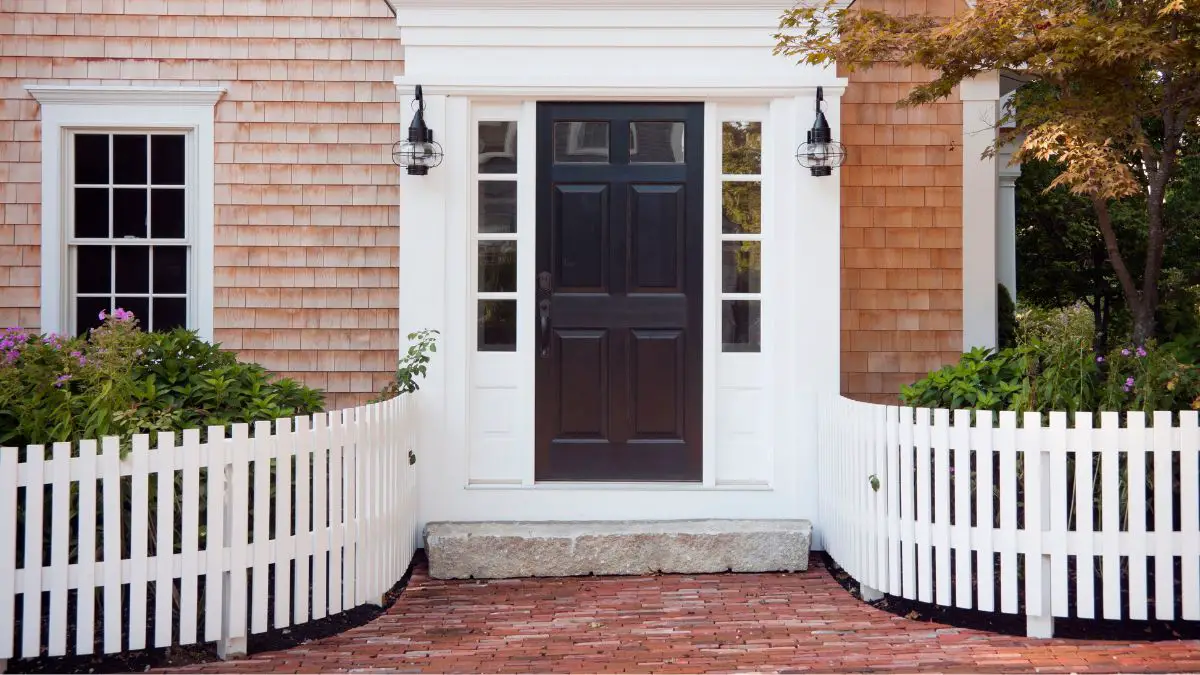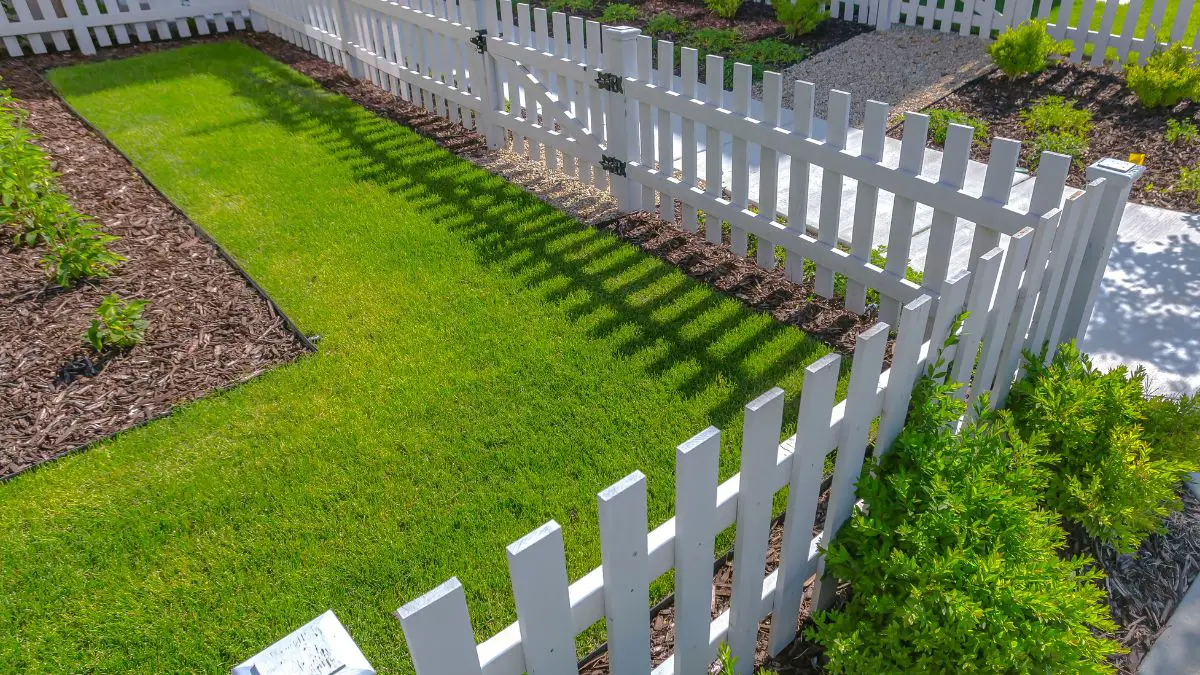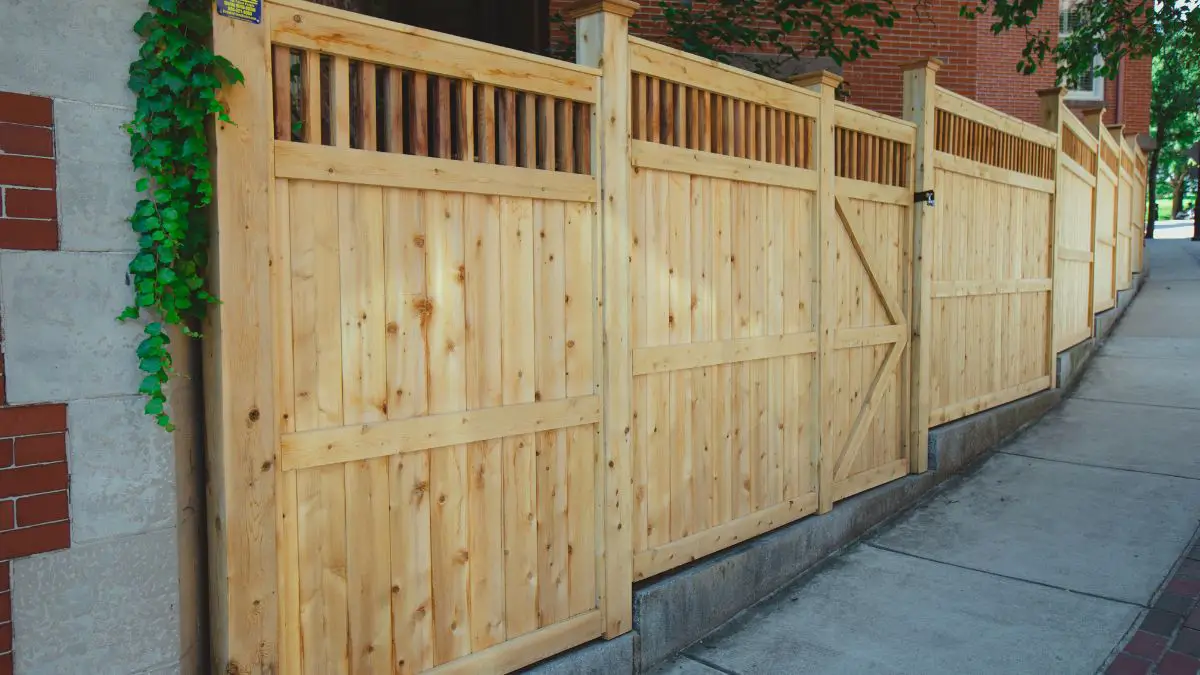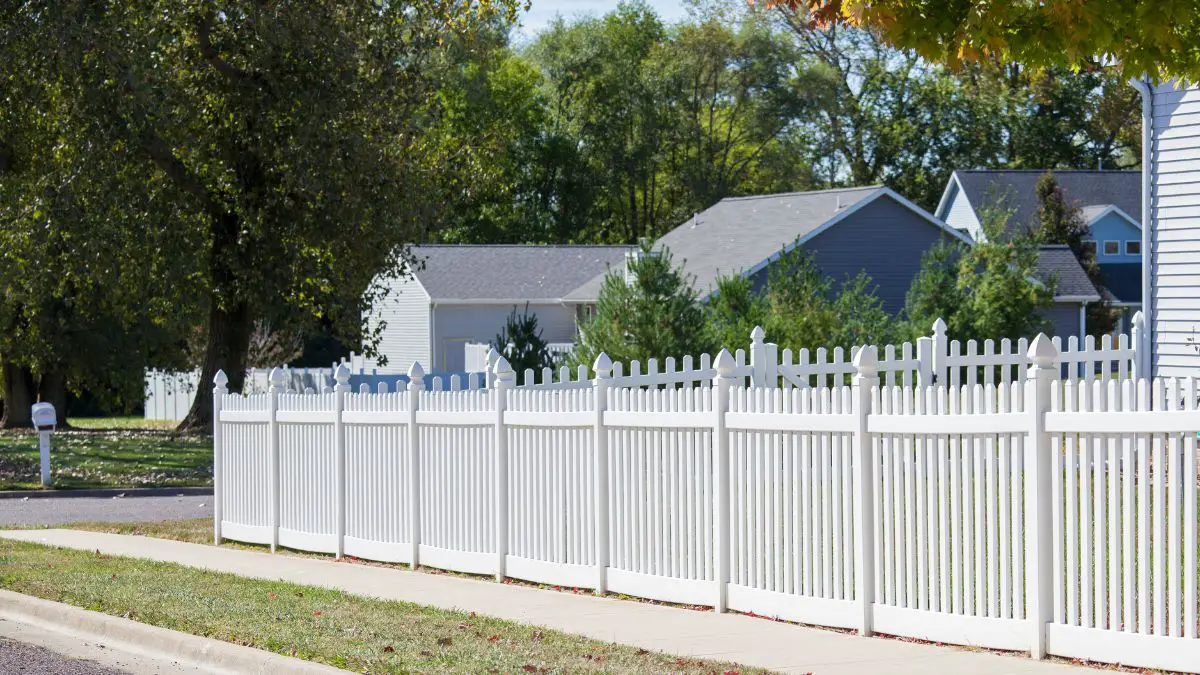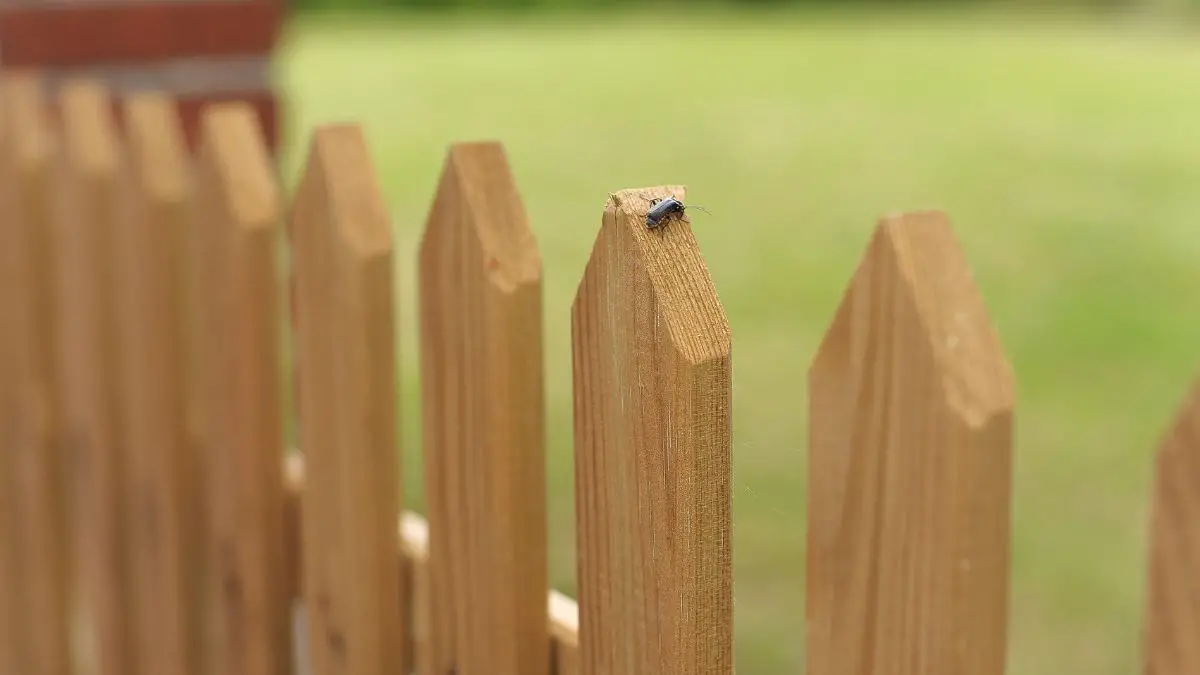The cost to stain a fence varies based on factors like fence size, stain type, labor costs, and the fence’s condition, with an average cost ranging from $750 to $4,250.
Staining your wooden fence isn’t just about enhancing its aesthetic appeal. It’s a strategic decision beyond surface-level beauty. It’s about investing in the longevity of your wood fence, protecting it from harsh elements and potential damage.
It’s about preserving the wood, preventing rot, and preventing pesky insects. It’s about ensuring that your wood fence stands strong and beautiful year after year, enhancing the look of your home and its value.
But let’s address the elephant in the room: the cost of staining a fence. It’s a valid concern that might keep you from taking the plunge. But don’t worry. We’re here to guide you through it.

Why Stain Your Fence?
Staining your fence is like giving it a shield, a protective layer that guards against harsh weather conditions, rot, and insects. The investment pays off in the long run, saving you from costly repairs or premature replacement.
A well-maintained fence can boost your property’s curb appeal, making it more attractive to potential buyers if you ever decide to sell.
The Cost Factors: What You Need to Know
The cost of staining a fence isn’t a one-size-fits-all figure. It varies, influenced by several factors that you should consider:
- Size and Length of Your Fence: A larger fence requires more fence stain and labor, increasing the overall fence stain cost.
- Type of Stain Used: Not all stains are created equal. Some offer more durability but come with a higher price tag.
- Labor Costs: If hiring a professional, labor rates will be a significant part of your budget.
- Condition of Your Fence: A fence in poor condition may need repairs before staining, adding to the cost.
- Additional Material Costs: Tools, cleaners, and fence sealers are often necessary for a staining project and will affect the total cost.
Understanding these factors will help you budget for your fence staining project effectively. Staining your fence is an investment in your property’s longevity and appeal. It’s a cost-effective strategy that pays off in the long run. So, are you ready to give your fence the care it deserves?
Why Stain a Fence? Unveiling the Benefits
Imagine your fence as a canvas. You can transform it into a masterpiece that defines your property and reflects your style. Staining your fence is one way to achieve this transformation.
Benefits of Staining Your Fence
Staining your fence is like providing it with a protective armor. It’s not just about enhancing its aesthetic appeal; it’s about ensuring its longevity and durability. Here are some compelling reasons to choose staining:
- A stained fence is better equipped to withstand harsh weather conditions. Rain, snow, or intense sun, the stain acts as a shield, protecting the wood from damage.
- Staining your fence can help prevent wood rot and deter insects, two common issues that can shorten the lifespan of your fence.
- Unlike a coat of paint, stain penetrates the wood, enhancing the natural beauty of the wood grain. It adds depth and character to your fence, making it a standout outdoor space feature.
- A stained fence requires less maintenance compared to an unstained one. It doesn’t chip or peel, reducing the need for frequent touch-ups.
Staining vs. Painting: A Comparison
Now, you might be considering painting your fence. While painting can give your fence a fresh look, it doesn’t offer the same benefits as staining. When painting a fence, you can expect more prep work to remove loose paint and apply 2 coats of paint for even coverage. Here’s how they compare:
- Durability: Stain penetrates the wood, offering better protection from the elements. Paint, on the other hand, sits on the surface and can chip or peel over time.
- Maintenance: Stained fences require less maintenance. Painted fences often need more frequent touch-ups due to peeling and chipping.
- Aesthetics: Semi-transparent stain enhances the natural beauty of the wood grain, giving your fence a more rustic and natural beauty of the wood to peak through. A gallon of solid stain provides a solid color stain, which can hide the wood grain.
- Cost: While the initial cost of staining a fence might be higher, the lower maintenance costs make it a more cost-effective choice in the long run.
Staining your fence is an investment that pays off in durability, beauty, and longevity. It’s a choice that makes your fence look good and keeps it in good shape for years to come. So, are you ready to transform your fence into a statement piece with stain?
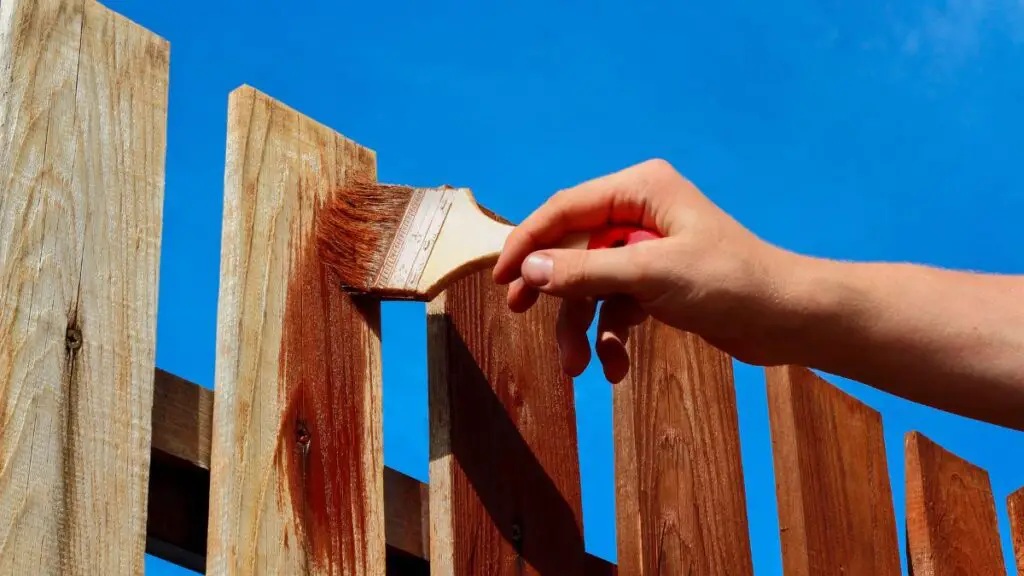
Factors Influencing the Cost to Stain a Fence: A Comprehensive Guide
Understanding the fence staining cost factors is crucial. It’s not just about getting a quote and setting a budget—it’s about knowing where your money is going and why. Let’s break down the key factors influencing the cost of staining a fence.
Size and Length of Your Fence
First and foremost, the average size fence and length of your fence significantly determine the staining cost. The larger the fence, the more stain you’ll need and the more time it will take to apply it. It’s simple math: square footage equals a higher cost.
But remember, this isn’t just about cost—it’s about value. A well-stained, large fence can enhance your property’s curb visual appeal and value.
Type of Stain Used
Not all stains are created equal. Some are more durable, some offer better protection, and some provide a more vibrant color. High-quality stains might come with a higher average price tag, but they also provide better value in terms of longevity and protection. It’s about finding the right balance between cost and quality.
Oil-based stains are best for cedar fencing as they won’t peel and provide more durability. However, water-based stains are easier to clean up and make the wood look lighter with a more natural finish.
Labor Costs
Are you planning to stain the fence yourself, or are you considering hiring a professional? Your answer will significantly impact the overall cost. DIY might seem cost-effective, but remember to invest time and effort. On the other hand, hiring a professional can ensure a high-quality finish and save you the hassle, but it will increase the cost.
Condition of Your Fence
The condition of your fence is another important factor. A good-condition fence will require less prep work, keeping costs down. But a fence in poor condition might need repairs before staining, which will add to the cost. Regular maintenance can help keep your fence in good condition and reduce the need for costly repairs.
Cost of Additional Materials
Staining a fence isn’t just about the stain itself. You’ll also need the additional cost of materials like paint brushes, paint rollers, paint sprayers, and cleaners. These costs can add up, so factoring them into your budget is important.
The cost to stain a fence is influenced by several factors, from the size and condition of your fence to the type of stain used and the labor cost. Understanding these factors can help you make an informed decision and ensure you get the best value for your money.
So, as you plan your fence staining project, consider these factors. They’ll guide you in setting a realistic budget, choosing the right materials, and deciding whether to DIY or hire a professional.
Staining your fence is an investment in your property’s beauty and longevity—it’s worth doing it right.
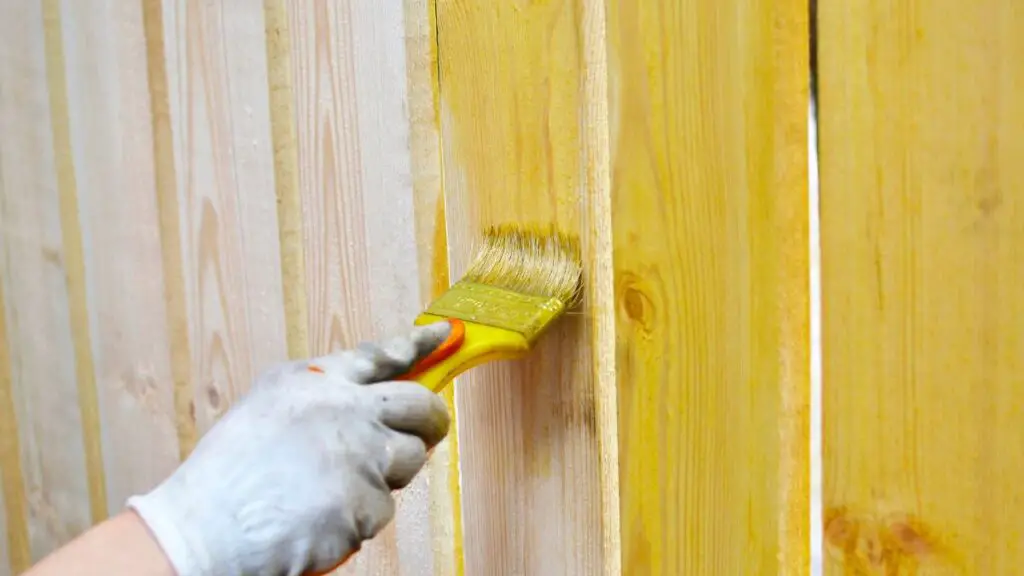
Unveiling the Average Cost to Stain a Fence
Unlike vinyl fences, wooden fences require more maintenance to protect against wood decay and UV light.
Several factors, including the total length of the fence, the choice between painting and staining, the condition of the fence, and the type of fence, influence the cost of staining or painting a fence.
Remember, a fence has two sides, and while you can only stain one side, it’s usually best to cover both sides for complete protection. However, sharing a fence with a neighbor is often difficult. It’s best to agree to share the cost of fence maintenance on a property line.
Therefore, while the cost per linear foot ranges from $2.25 to $10, this cost is typically doubled as both sides of the fence are usually stained. This brings the total cost to $4.50 to $20 per linear foot.
| Linear Feet | Price Range |
|---|---|
| 25 | $112.50 – $500 |
| 50 | $225 – $1,000 |
| 75 | $337.50 – $1,500 |
| 100 | $450 – $2,000 |
| 150 | $675 – $3,000 |
| 200 | $900 – $4,000 |
| 300 | $1,350 – $6,000 |
| 400 | $1,800 – $8,000 |
This table provides the price range for different linear feet measurements. The given values represent the approximate cost range for the specified linear footage.
Cost Per Square Foot
The cost per square foot is a key factor in the overall cost of staining your fence. This cost typically includes both the stain and the labor. You can expect to pay between $1.50 and $2.50 per square foot. However, this can vary depending on the type of stain you choose and the rates of the professional you hire.
Cost Per Gallon of Stain
The stain is another significant factor; a gallon of high-quality stain costs between $30 and $40. However, the exact price can vary depending on the brand and type of stain you choose. High-quality, durable extra coat stains might cost more, but they can offer better protection and longevity, providing more value for your money.
Cost Variation by Fence Height
The height of your fence can also impact the cost of staining. A taller fence has more surface area to cover, which increases the cost. Here’s a cost breakdown based on fence height:
| Length | Price Range per Linear Foot |
|---|---|
| 4 Feet | $2.25 – $3.50 |
| 6 Feet | $3.25 – $5.75 |
| 8 Feet | $4.50 – $7.50 |
| 10 Feet | $6.50 – $9.00 |
| 12 Feet | $8.50 – $10.00 |
This table provides the price range per linear foot for different lengths, allowing you to easily compare and choose the appropriate option based on your needs.
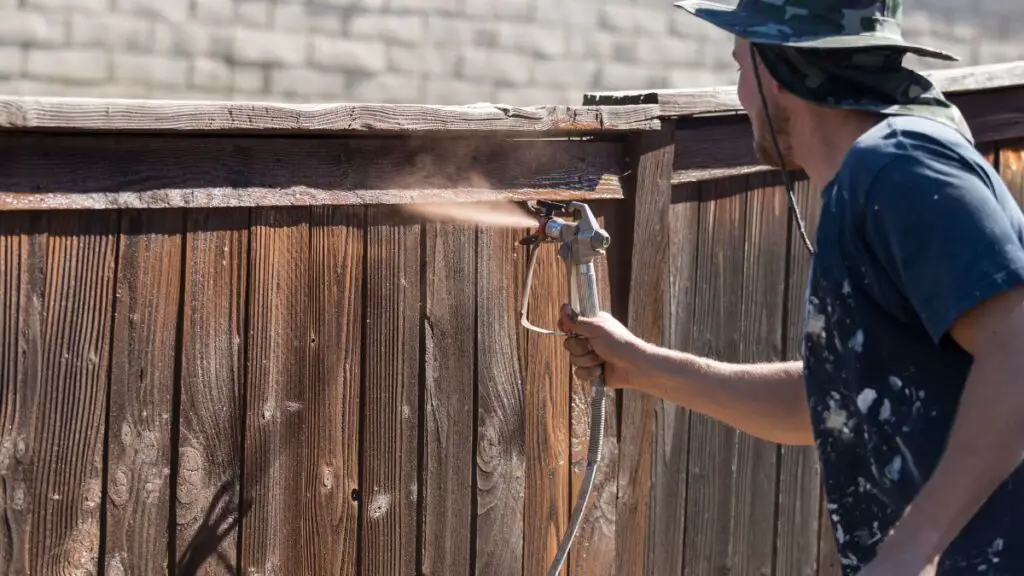
Fence Painting Costs by Type of Fence
The cost of a fence can vary significantly depending on the type of fence, as each has unique characteristics and surface areas that need to be painted. Here’s a breakdown of the costs associated with painting different types of fences:
Wood Fence Material
The wooden fence material can affect the stain you use. For example, if you’re working with a cedar fence, an oil-based wood stain is recommended as it penetrates the softwood more effectively.
According to the University of Massachusetts, if you are painting wood fencing, research conducted by the Forest Products Laboratory in Madison, WI, clearly shows that even a 3-week exposure to sun and rain is too much for new wood. However, weathered wood is not a bad idea if you plan to stain it. Loose fibers and the roughened texture absorb penetrating stains better.
Wood Split Rail and Post and Rail Fences
These fences have a lot of space between the rails, but all sides of the rails need to be painted. Staining a fence typically ranges from $2.25 to $3.50 per linear foot or $940 to $1,465 for a ¼ acre.
Wood Picket Fences
Picket fences cost more to paint than rail fences due to their larger surface area. Painting a picket fence is usually between $2.75 and $4 per linear foot or $1,150 to $1,675 for a ¼ acre.
Wood Privacy Fences
Wood privacy fences, including horizontal, stockade, dog ear, and shadowbox fences, have some of the highest staining costs because they have the most area to cover. The cost to paint these fences ranges from $4 to $12 per linear foot or $1,675 to $5,015 for a ¼ acre.
Total Average Cost to Stain a Fence
So, what’s the bottom line? You can expect to pay between $750 and $4,250 to stain a fence, with the average cost being around $1,700. This includes the cost of the stain, labor, and additional materials.
Coats of stain on your fence are an investment. It’s about enhancing the beauty of your fence, protecting it from damage, and extending its lifespan.
It’s not just about the cost but the value, longevity, and beauty a well-stained fence can add to your property.
DIY vs. Hiring a Professional
When examining the cost of staining a fence, you have two main options: roll up your sleeves and do it yourself, or hire a professional. Each option has pros and cons; the best choice depends on your circumstances and preferences.
The DIY Route
Going the DIY route can be a rewarding experience. You have complete control over the project, from the stain to the application technique. It’s a hands-on approach that can give you a sense of accomplishment.
Pros of DIY
- By doing the work yourself, you can save on labor costs.
- You have complete control over every aspect of the project.
- You can work at your own pace and on your own schedule.
Cons of DIY
- Staining a fence can be a time-consuming project, especially if you’re new to it.
- Without professional experience, the final result might not be as high-quality.
- If you make a mistake, you might end up spending more on repairs or additional materials
Hiring a Professional
Hiring professional fence stainers can ensure a high-quality result. Professionals have the experience and skills to do stain jobs efficiently and effectively.
Pros of Hiring a Professional
- Professionals have the skills and experience to deliver high-quality results.
- A professional can complete the project faster than you might be able to on your own.
- Hiring a professional means, you don’t have to worry about the details of the project.
Cons of Hiring a Professional
- Hiring a professional is typically more expensive than doing it yourself.
- You won’t have as much control over the details of the project.
Cost Comparison
On average, DIY fence staining can cost between $500 and $1,000, depending on the size of your fence and the type of stain you choose. Hiring a professional, on the other hand, can cost between $750 and $4,250.
The choice between DIY and hiring a professional depends on your budget, skills, and preferences. Both options have their pros and cons, and the best choice is the one that suits your specific needs and circumstances.
Whether you do it yourself or hire a professional, remember that staining your fence is an investment in its longevity and beauty.

Additional Costs and Considerations for Fence Staining
Special Staining Treatments
The quality of your stain plays a crucial role in protecting your fence from fading and weather damage.
Opting for high-quality, fade-resistant, and moisture-resistant stains can provide superior protection. These premium stains typically cost between $50 and $70 per gallon.
If you’re using a transparent or translucent stain, consider one with an included fence sealer, ranging from $50 to $120 per gallon.
Staining treatments, such as using different colors to highlight your fence’s features. This approach requires additional work, increasing the cost of fence staining per square foot from $0.50 to $1.25.
Ensuring the Longevity of Your Stained Fence: A Maintenance Guide
Staining your fence is just the beginning. Regular maintenance is key to ensure its longevity and keep it looking its best. Here’s how to take care of your stained fence and when to consider restaining.
Maintaining Your Stained Fence
A well-maintained fence can stand strong and beautiful for years. Here are some tips to keep your stained fence in top shape:
- Regular Cleaning: Keep your fence clean by using a pressure washer to remove dirt and debris. A light pressure washing with a garden hose and a soft brush can do the trick too.
- Inspection: Regularly inspect your fence for signs of damage or wear. Look for peeling stains, wood rot, or insect damage. Early detection can save you from costly repairs down the line.
- Repairs: If you notice any damage during your inspection, repair it promptly. This might involve replacing a fence board, fixing a loose nail, or patching a hole.
When to Restain Your Fence
The longevity of your stain depends on several factors, including the type of stain, the weather conditions, and the condition of your wood. On average, a fence should be restained every 2-3 years. However, it might be time to restain if you notice the color fading or the wood turning gray.
Want to make your stain last longer?
Here are some tips:
- Choose a High-Quality Stain: High-quality stains offer better protection and longevity. They might cost more upfront but can save you money in the long run.
- Apply the Stain Correctly: Proper application can extend the life of your stain. This means preparing the wood properly, applying the stain in the right conditions, and allowing it to dry fully.
- Protect Your Fence: Protect your fence from damage. This might involve trimming back plants touching the fence, redirecting your sprinklers to avoid water damage, or installing a fence guard to protect from lawn equipment.
Maintaining your stained fence is ongoing but pays off in the long run. With regular care and timely restaining, your fence can remain a beautiful and valuable part of your property for years.
FAQs About Staining a Fence
Staining a fence can bring up a lot of questions. Here are answers to some of the most frequently asked questions to help you navigate your fence staining project with confidence.
How often should I stain my fence?
The frequency of staining your fence depends on several factors, including the type of stain used, the weather conditions in your area, and the condition of your wood. A fence should be restained every 2-3 years. It’s time to restain when you notice the color fading or the wood turning gray.
Can I stain over old stain?
Yes, you can stain over old stains as long as the old stain is in good condition. If the old stain is peeling or flaking, you must remove it before applying a new stain.
What is the best stain for a fence?
The best stain for your fence depends on your specific needs and preferences. High-quality, oil-based stains are generally recommended for their durability and protection. However, the color and finish are up to you.
How long does it take to stain a fence?
The time it takes to stain a fence can vary depending on your fence’s size and the application method. On average, it can take a few hours to a few days. Remember to factor in drying time, which can take 24 to 48 hours.
Wrapping Up: The Value of Staining Your Fence
Staining your fence is more than just a cosmetic upgrade. It’s a strategic decision that enhances the longevity and durability of your fence. It’s about protecting your fence from the elements, preventing wood rot, and deterring insects. It’s about enhancing the natural colors of your wood grain and transforming your fence into a standout feature of your outdoor space.
The cost of staining a fence is influenced by several factors, including the size and condition of your fence, the type of stain you choose, and whether you do it yourself or hire a professional.
While the initial fence cost might seem high, staining your fence is an investment. It’s about saving on future repair costs, extending your fence’s lifespan, and enhancing your property’s value.
The process of staining a fence requires careful planning and execution. From preparing your fence and choosing the right stain to apply the stain and maintaining your fence, each step is crucial to the success of your project.


